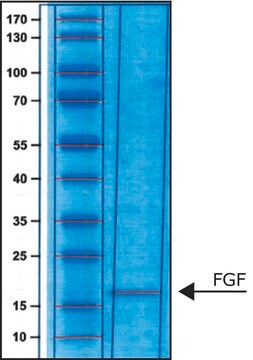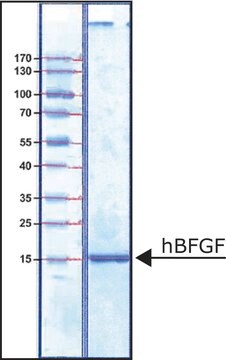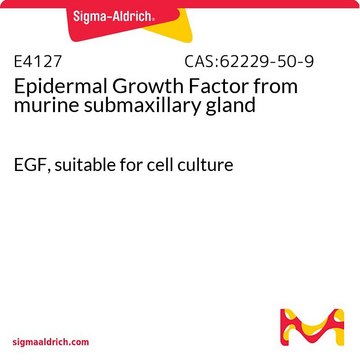F5542
Fibroblast Growth Factor-Acidic human
≥97% (SDS-PAGE), recombinant, expressed in E. coli, suitable for cell culture
Sinónimos:
FGF-1, aFGF
About This Item
Productos recomendados
product name
Fibroblast Growth Factor-Acidic human, FGF-Acidic, recombinant, expressed in E. coli, suitable for cell culture
origen biológico
human
Nivel de calidad
recombinante
expressed in E. coli
Análisis
≥97% (SDS-PAGE)
formulario
lyophilized powder
potencia
0.287 ng/mL
calidad
endotoxin tested
mol peso
15.5 kDa
envase
pkg of 25 μg
condiciones de almacenamiento
avoid repeated freeze/thaw cycles
técnicas
cell culture | mammalian: suitable
impurezas
≤1.0 EU/mg (LAL test)
Nº de acceso UniProt
temp. de almacenamiento
−20°C
Información sobre el gen
human ... FGF1(2246)
Descripción general
Aplicación
- as a component of growth factor cocktail for treating neural stem cell (NSC) transplants
- as a component of Human Neural Stem Cell (HNSC) proliferation medium for Neural Tissue Spheres (NTS) propagation
- as a growth factor component in fibrin matrix to support embryonic day 14 (E14) cells graft survival
Acciones bioquímicas o fisiológicas
Forma física
Nota de análisis
Código de clase de almacenamiento
11 - Combustible Solids
Clase de riesgo para el agua (WGK)
WGK 3
Punto de inflamabilidad (°F)
Not applicable
Punto de inflamabilidad (°C)
Not applicable
Equipo de protección personal
Eyeshields, Gloves, type N95 (US)
Certificados de análisis (COA)
Busque Certificados de análisis (COA) introduciendo el número de lote del producto. Los números de lote se encuentran en la etiqueta del producto después de las palabras «Lot» o «Batch»
¿Ya tiene este producto?
Encuentre la documentación para los productos que ha comprado recientemente en la Biblioteca de documentos.
Los clientes también vieron
Artículos
Fibroblast growth factors in cell culture and various growth factors for your research
Role of growth factors in stem cell differentiation and various growth factors for your research at sigmaaldrich.com
Nuestro equipo de científicos tiene experiencia en todas las áreas de investigación: Ciencias de la vida, Ciencia de los materiales, Síntesis química, Cromatografía, Analítica y muchas otras.
Póngase en contacto con el Servicio técnico













